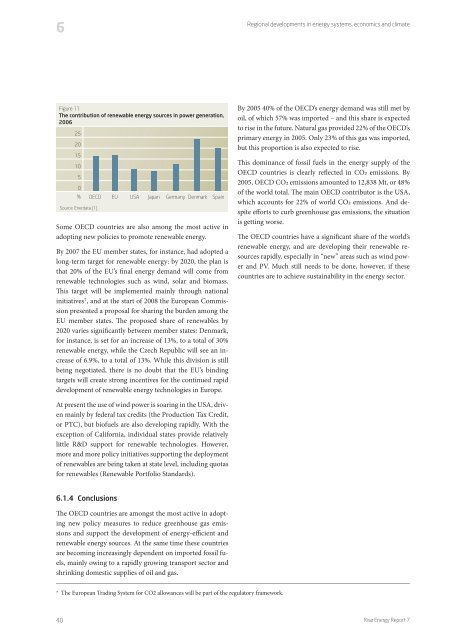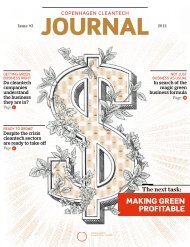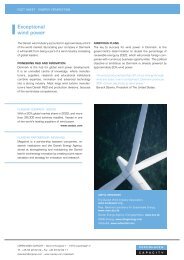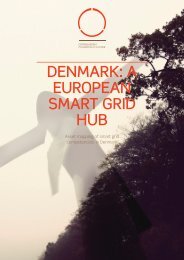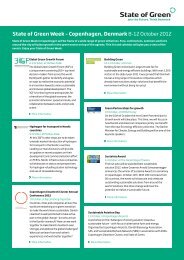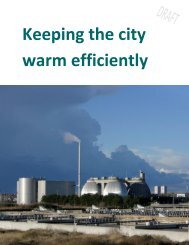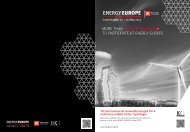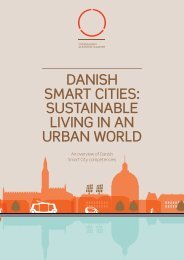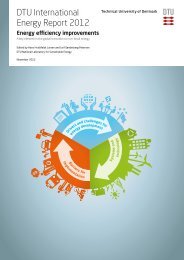Future low carbon energy systems - Copenhagen Cleantech Cluster
Future low carbon energy systems - Copenhagen Cleantech Cluster
Future low carbon energy systems - Copenhagen Cleantech Cluster
You also want an ePaper? Increase the reach of your titles
YUMPU automatically turns print PDFs into web optimized ePapers that Google loves.
6Regional developments in <strong>energy</strong> <strong>systems</strong>, economics and climateFigure 11The contribution of renewable <strong>energy</strong> sources in power generation,20062520151050% OECD EU USA Japan Germany Denmark SpainSource: Enerdata [1]Some OECD countries are also among the most active inadopting new policies to promote renewable <strong>energy</strong>.By 2007 the EU member states, for instance, had adopted along-term target for renewable <strong>energy</strong>: by 2020, the plan isthat 20% of the EU’s final <strong>energy</strong> demand will come fromrenewable technologies such as wind, solar and biomass.This target will be implemented mainly through nationalinitiatives7, and at the start of 2008 the European Commissionpresented a proposal for sharing the burden among theEU member states. The proposed share of renewables by2020 varies significantly between member states: Denmark,for instance, is set for an increase of 13%, to a total of 30%renewable <strong>energy</strong>, while the Czech Republic will see an increaseof 6.9%, to a total of 13%. While this division is stillbeing negotiated, there is no doubt that the EU’s bindingtargets will create strong incentives for the continued rapiddevelopment of renewable <strong>energy</strong> technologies in Europe.By 2005 40% of the OECD’s <strong>energy</strong> demand was still met byoil, of which 57% was imported – and this share is expectedprimary <strong>energy</strong> in 2005. Only 23% of this gas was imported,but this proportion is also expected to rise.This dominance of fossil fuels in the <strong>energy</strong> supply of theOECD countries is clearly reflected in CO2 emissions. By2005, OECD CO2 emissions amounted to 12,838 Mt, or 48%of the world total. The main OECD contributor is the USA,which accounts for 22% of world CO2 emissions. And despiteefforts to curb greenhouse gas emissions, the situationis getting worse.The OECD countries have a significant share of the world’srenewable <strong>energy</strong>, and are developing their renewable resourcesrapidly, especially in “new” areas such as wind powerand PV. Much still needs to be done, however, if thesecountries are to achieve sustainability in the <strong>energy</strong> sector.At present the use of wind power is soaring in the USA, drivenmainly by federal tax credits (the Production Tax Credit,or PTC), but biofuels are also developing rapidly. With theexception of California, individual states provide relativelylittle R&D support for renewable technologies. However,more and more policy initiatives supporting the deploymentof renewables are being taken at state level, including quotasfor renewables (Renewable Portfolio Standards).6.1.4 ConclusionsThe OECD countries are amongst the most active in adoptingnew policy measures to reduce greenhouse gas emissionsand support the development of <strong>energy</strong>-efficient andrenewable <strong>energy</strong> sources. At the same time these countriesare becoming increasingly dependent on imported fossil fuels,mainly owing to a rapidly growing transport sector andshrinking domestic supplies of oil and gas.7 The European Trading System for CO2 al<strong>low</strong>ances will be part of the regulatory framework.40Risø Energy Report 7


